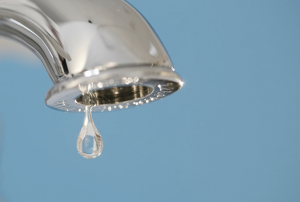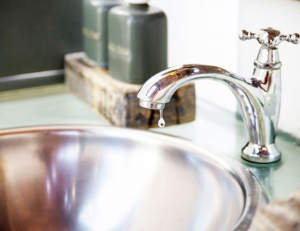 There are many plumbing problems more serious, expensive, and even dangerous than a dripping faucet. Obviously, right? At least, it seems obvious. Then, when you don’t address it, you’re forced to hear the constant “plink, plink, plink, plinking” of a dripping faucet for days on end. Suddenly, you’re not so sure there’s anything worse than a dripping faucet – “plink, plink, plink, plink…”
There are many plumbing problems more serious, expensive, and even dangerous than a dripping faucet. Obviously, right? At least, it seems obvious. Then, when you don’t address it, you’re forced to hear the constant “plink, plink, plink, plinking” of a dripping faucet for days on end. Suddenly, you’re not so sure there’s anything worse than a dripping faucet – “plink, plink, plink, plink…”
For how intimately familiar you are with the sound of a dripping faucet – plink (pause, wait…) plink (pause, wait…) plink (pause, wait…), do you actually know where the sound is coming from?
Believe it or not, that dripping sound may not happen for the reasons you think it’s happening. Why does that matter? Well, if you know why dripping faucets really make that sound, you’ll be able to stop the sound. Want to stop the sound? Here’s where the infernal “plink” really comes from, and what you can do to shut it up for good.
What is actually making that plink, plink sound?
 Researchers at the University of Cambridge (no doubt fed up with the “plink” themselves) recently studied dripping faucets using ultra-high-speed cameras. What they found was somewhat unexpected. The plinking noise produced by a dripping faucet isn’t produced by the impact of the droplet into the sink. It’s actually coming from a small bubble of air trapped beneath the surface of the water droplet.How is that different from what you thought? It’s a fair question. Basically, when a water droplet hits another liquid surface, a couple things happen. First, at the moment the droplet hits the surface of the liquid, it forms a cavity in that liquid. That cavity recoils just as quickly, creating a rising column of liquid. The cavity recoils so quickly, in fact, that it creates the small air bubble we’re talking about. This process is called “bubble entrainment.” We used to think the plink was coming from the cavity, the recoil, or the rising column of liquid. Now, we know it’s not coming from any of those things; it’s actually coming from the air bubble.
Researchers at the University of Cambridge (no doubt fed up with the “plink” themselves) recently studied dripping faucets using ultra-high-speed cameras. What they found was somewhat unexpected. The plinking noise produced by a dripping faucet isn’t produced by the impact of the droplet into the sink. It’s actually coming from a small bubble of air trapped beneath the surface of the water droplet.How is that different from what you thought? It’s a fair question. Basically, when a water droplet hits another liquid surface, a couple things happen. First, at the moment the droplet hits the surface of the liquid, it forms a cavity in that liquid. That cavity recoils just as quickly, creating a rising column of liquid. The cavity recoils so quickly, in fact, that it creates the small air bubble we’re talking about. This process is called “bubble entrainment.” We used to think the plink was coming from the cavity, the recoil, or the rising column of liquid. Now, we know it’s not coming from any of those things; it’s actually coming from the air bubble.
How does an air bubble make that sound?
The impact of the water droplet creates an air bubble in the surface of the water the droplet collides with. This air bubble happens when air rushes in to fill the cavity created when the droplet collides with the liquid surface. When the cavi
bubble happens when air rushes in to fill the cavity created when the droplet collides with the liquid surface. When the cavi
ty recoils from the surface of the water, the force of the breakaway separates the air bubble from the cavity. The air bubble shoots down into the liquid the drop originally collided with. The force of the breakaway also makes the bubble oscillate violently as it pushes into the liquid.
This sudden break forces the air bubble to oscillate up and down violently. This oscillation sends reverberations shooting through the water’s surface. These reverberations hit the bottom of the cavity, driving it up and down like a piston. As the cavity rises and falls, it “shoots” soundwaves up into the air. Those sound waves are the “plink” we’re all so use to hearing. Basically, the air bubble bounces up and down in the water and makes the cavity propel sound upward.
 Why Does That Matter to Me?
Why Does That Matter to Me?
Understanding the underlying mechanics of the “plink” can help us understand how to stop it better. Up until this research, no one really understood exactly what was causing the “plink” sound itself. Most people just assumed it was the dripping, and it was unavoidable as long as the drip persisted. Now, however, we know that the air bubble’s oscillation inside liquid drives the “plinking” sound. If we can stop that oscillation, we can stop the “plink,” even before we stop the dripping.
 The secret has to do with the surface tension of the liquid where the air bubble develops. Ultimately, the plink happens because when the air bubble oscillates, the liquid surface oscillates with it. If you stop the water surface from oscillating along with the air bubble, therefore, you’ll stop the sound. The way to do that is by changing the surface tension of the liquid surface. Try adding dish soap to the liquid beneath the dripping faucet. The dish soap should change the liquid surface enough to hamper its oscillation. You’ll still see the drop fall, but you won’t hear the plink!
The secret has to do with the surface tension of the liquid where the air bubble develops. Ultimately, the plink happens because when the air bubble oscillates, the liquid surface oscillates with it. If you stop the water surface from oscillating along with the air bubble, therefore, you’ll stop the sound. The way to do that is by changing the surface tension of the liquid surface. Try adding dish soap to the liquid beneath the dripping faucet. The dish soap should change the liquid surface enough to hamper its oscillation. You’ll still see the drop fall, but you won’t hear the plink!
 Of course, there’s a more permanent solution to your plinking problem. Call Cass Plumbing of Tampa Bay to fix the dripping faucet itself! The plumbing professionals at Cass Plumbing will stop the faucet from dripping completely anywhere in or around the Greater Tampa Bay Area. You won’t have to worry about stopping the plink yourself. Plus, you’ll save money on your water bill. Dripping faucets in Tampa Bay get surprisingly expensive!
Of course, there’s a more permanent solution to your plinking problem. Call Cass Plumbing of Tampa Bay to fix the dripping faucet itself! The plumbing professionals at Cass Plumbing will stop the faucet from dripping completely anywhere in or around the Greater Tampa Bay Area. You won’t have to worry about stopping the plink yourself. Plus, you’ll save money on your water bill. Dripping faucets in Tampa Bay get surprisingly expensive!
If you need your dripping faucet fixed fast and want to completely stop that plinking sound, call the professionals at Cass Plumbing today at 813-265-9200.






